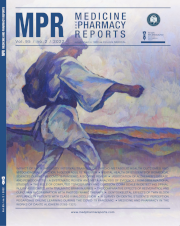Dentoskeletal effects of Twin Block appliance in patients with Class II malocclusion
DOI:
https://doi.org/10.15386/mpr-1989Keywords:
Twin Block, Class II division 1 malocclusion, functional appliances, dentoskeletal effect, cephalometryAbstract
Background and aim. Class II malocclusions are most commonly seen in orthodontic practice and in the recent times Twin Block appliance has been the most popular and widely used among removable functional appliances for the correction of Class II malocclusion in growing patients. The aim of this retrospective study was to evaluate the dentoskeletal effects produced by the Twin Block appliance for the correction of Class II division 1 malocclusion with retrognathic mandible.
Methods. Pre-treatment (T1) and post-treatment (T2) lateral cephalograms of 30 patients treated with Twin Block appliance (mean age = 10.8 ± 1.2 years) for the correction of class II division 1 malocclusion were compared with the 30 untreated class II control patients (mean age 11.2 ± 0.8 years) who did not undergo any treatment during this period. Both the groups were evaluated for the dentoskeletal changes using 24 angular and linear cephalometric measurements. The differences between the pre and post-treatment were calculated using a paired t-test.
Results. The cephalometric analysis revealed that the Twin Block appliance stimulated mandibular growth and statistically significant differences were found between the two groups. Twin Block patients showed a statistically very high significant (p<0.001) increase in mandibular length (6.02 mm) compared with the control group (0.3 mm). ‘Headgear effect’ on the maxilla, increase in lower anterior facial height, significant reduction of overjet, overbite and Class I molar relationship was achieved in the Twin Block group. However, no significant changes appeared in the control group.
Conclusion: The results of the present study conclude that the Twin Block appliance is effective in the treatment of Class II malocclusion and this is due to a combination of skeletal and dentoalveolar changes in both the arches.
Downloads
Published
How to Cite
Issue
Section
License
The authors are required to transfer the copyright of the published paper to the journal. This is done by agreeing to sign the Copyright Assignment Form. Whenever the case, authors are also required to send permissions to reproduce material (such as illustrations) from the copyright holder.

The papers published in the journal are licensed under a Creative Commons Attribution-NonCommercial-NoDerivatives 4.0 International License.

